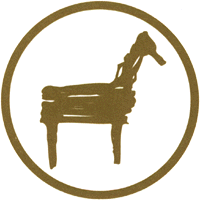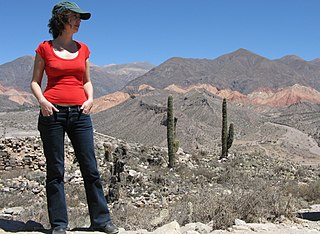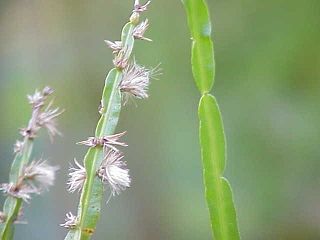
Ethnobotany is the study of a region's plants and their practical uses through the traditional knowledge of a local culture and people. An ethnobotanist thus strives to document the local customs involving the practical uses of local flora for many aspects of life, such as plants as medicines, foods, intoxicants and clothing. Richard Evans Schultes, often referred to as the "father of ethnobotany", explained the discipline in this way:
Ethnobotany simply means investigating plants used by primitive societies in various parts of the world.

Ethnobiology is the scientific study of the way living things are treated or used by different human cultures. It studies the dynamic relationships between people, biota, and environments, from the distant past to the immediate present.

Moneses uniflora, the one-flowered wintergreen, single delight, wax-flower, shy maiden, star of Bethlehem (Aleutians), St. Olaf's candlestick (Norway), wood nymph, or frog's reading lamp, is a plant of the family of Ericaceae, that is indigenous to moist coniferous forests in temperate regions of the Northern Hemisphere from Spain to Japan and across North America. It is the sole member of genus Moneses.

Euterpe precatoria is a tall, slender-stemmed, pinnate-leaved palm native to Central and South America and Trinidad and Tobago. E. precatoria is used commercially to produce fruits, although Euterpe oleracea is more commonly cultivated due to its larger fruits.

Nancy Jean Turner is a Canadian ethnobiologist, originally qualified in botany, who has done extensive research work with the indigenous peoples of British Columbia, the results of which she has documented in a number of books and numerous articles.

Dipteryx alata is a large, undomesticated, edible nut-bearing tree from dryish tropical lowlands in central South America belonging to the legume family, Fabaceae, from the Dipterygeae tribe in the Faboideae subfamily. It is a wild species, widespread across the Cerrado savanna in South America. The baru nut seed is a grain legume, growing in popularity in North America as a snack food.

Aerial stem modifications are modifications to the aerial stems, vegetative buds and floral buds of plants growing in different conditions and which perform functions such as climbing, protection, support, synthesis of food, or vegetative propagation. Aerial stem structures that undergo modifications to perform these special functions include tendrils, thorns, hooks, phylloclade, tuberous stems, and bulbils. The auxiliary or the terminal part of the modified structures shows their stem nature.
Botrychium onondagense is a species of fern in the family Ophioglossaceae that is closely related to the more common Botrychium lunaria. It is known from many locations in the temperate areas of the Northern Hemisphere including Europe, Russia, Canada, and the United States. It was first described in 1903, but has long been regarded as a synonym for Botrychium lunaria.

The Society for Ethnobotany is an international learned society covering the fields of ethnobotany and economic botany. It was established in 1959. In 2022 the Society voted to change its name from the Society for Economic Botany to the Society for Ethnobotany, going into effect in June 2023. Its official journal is Economic Botany, published on their behalf by Springer Science+Business Media and the New York Botanical Garden Press. The society also publishes a biannual newsletter, Plants and People. The society organizes annual meetings at different locations around the world, where it awards the prize of Distinguished Ethnobotanist to particularly meritorious individuals.
Jan Salick is an American botanist who researches the interaction between humans and plants (ethnobotany) and conservation biology. Her specialisms include alpine environments, climate change, indigenous peoples and traditional knowledge. She is a past-president of the Society for Economic Botany and holds their Distinguished Economic Botanist award. She is also Fellow of the American Association for the Advancement of Science and received the Fairchild Medal for Plant Exploration. In 2019 she retired as Senior Curator of Ethnobotany at the Missouri Botanical Garden, and now has emerita status.

Ina Vandebroek is an ethnobotanist working in the areas of floristics, ethnobotany and community health. Since 2005, she has worked at the New York Botanical Garden in the Institute of Economic Botany. She has worked on ethnobotanical projects in North America, the Caribbean, and South America.
Azorella atacamensis is a species of flowering plant in the genus Azorella found in Argentina and Chile.

Narel Y. Paniagua-Zambrana is a Bolivian ethnobotanist. She investigates the use and protection of traditional knowledge of plants in indigenous communities, particularly in the Bolivian Andes. She is currently an Associated Researcher at the Herbario Nacional de Bolivia, Instituto de Ecología, Universidad Mayor de San Andres in Bolivia. Her goal is giving them the knowledge to participate in decision-making on the conservation of their intangible cultural heritage.
Brian Morey Boom is an American botanist who specializes in the flora of the Guianas and the Caribbean, the family Rubiaceae, ethnobotany, and economic botany.

Michael Jeffrey Balick is an American ethnobotanist, economic botanist, and pharmacognosist, known as a leading expert on medicinal and toxic plants, biocultural conservation and the plant family Arecaceae (palms).

Baccharis genistelloides is a species of flowering plant from the family Asteraceae. B. genistelloides is one of the most studied species in its genus Baccharis regarding its phytochemistry and pharmacological effects. The plant species is widely used in folk medicine.

The medical ethnobotany of India is the study of Indian medicinal plants and their traditional uses. Plants have been used in the Indian subcontinent for treatment of disease and health maintenance for thousands of years, and remain important staples of health and folk medicine for millions. Indians today utilize plants for both primary medical care and as supplementary treatment alongside modern medical science. It is estimated that 70% of rural Indians use traditional plant based remedies for primary healthcare needs. This reliance of plants for medicine is consistent with trends widely observed in the developing world, where between 65% and 80% of people use medicinal plant remedies.
Cussonia holstii is a small to medium size tree belonging to the family Araliaceae. The tree is similar in shape to a paw paw tree.
Vinca erecta is a species of flowering plant in the family Apocynaceae.
Myrianthus holstii is a plant species within the family Urticaceae. It grows either as a shrub or tree. It is considered a dioecious species but a monoecious tree has been observed.













